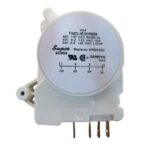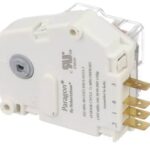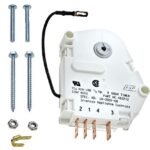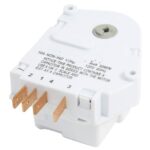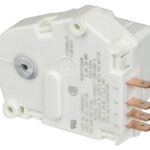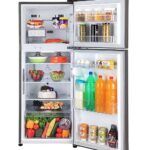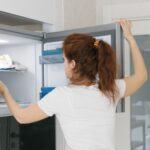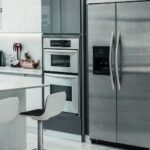Is your freezer not freezing? Don’t wait any longer; explore our comprehensive troubleshooting guide for ‘Freezer Not Freezing’ and bring your freezer back to its optimal performance today!
“Chill Out: Your Guide to Freezer Troubleshooting Success”
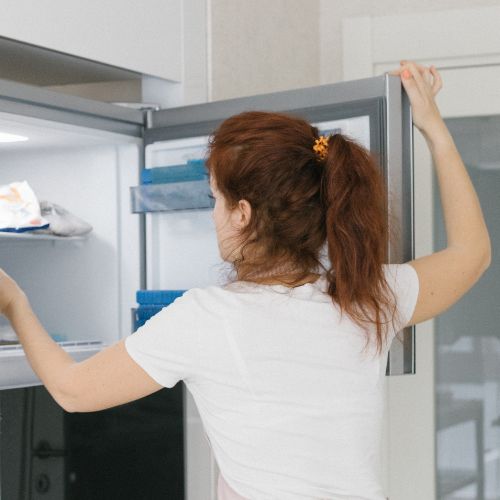
I. Introduction
A. The Importance of a Properly Functioning Freezer
A well-functioning freezer is an indispensable appliance in any household. It serves as a primary tool for preserving food, reducing waste, and saving money. Whether you’re storing leftovers, freezing fresh produce, or keeping meats and ice cream at the perfect temperature, a reliable freezer is essential for maintaining the quality and safety of your food.
The consequences of a malfunctioning freezer can range from minor inconveniences to significant financial losses. To prevent these issues, understanding how to troubleshoot and resolve problems with your freezer is crucial.
B. Common Signs of a Freezer Not Freezing
Recognizing when your freezer is not operating at its best is the first step in preventing a minor inconvenience from turning into a significant issue. Here are some common signs that indicate your freezer might not be freezing properly:
- Softened or Thawed Food: Frozen items are thawed or have noticeable ice crystals, indicating inconsistent freezing.
- Ice Cream Texture: Ice cream is rock hard when it’s properly frozen. If it’s become soft or grainy, your freezer might not be cold enough.
- Frost Buildup: Excessive frost on the freezer’s interior walls or food items suggests a cooling problem.
- Strange Noises: Unusual sounds, like buzzing, hissing, or clicking, may be signs of a problem with the compressor or other components.
- Water Leakage: Puddles of water inside or around the freezer can signal a problem with the defrost system or blocked drainage.
- Increased Energy Bills: A freezer that’s working harder to maintain temperature can lead to higher energy consumption and bills.
- Inaccurate Temperature Readings: Use a thermometer to check the actual temperature inside the freezer; discrepancies indicate a problem.
- Food Spoilage: Frequent spoilage of frozen items suggests a lack of proper cooling, which can lead to food waste.
Understanding these signs will empower you to take timely action, troubleshoot the issue, and potentially avoid costly repairs or replacements down the road. In this guide, we will walk you through the process of diagnosing and addressing common problems that can cause a freezer to stop freezing effectively.
II. Safety Precautions
Ensuring the safety of both yourself and your frozen goods is a critical step when dealing with a freezer that’s not freezing correctly. Follow these safety precautions to avoid accidents and further food spoilage:
A. Unplug the Freezer
Before you begin any troubleshooting or maintenance on your freezer, it’s imperative to disconnect it from the power source. Unplugging the freezer eliminates the risk of electrical shock and allows you to work on it safely. It’s also a precaution against the freezer unexpectedly starting up while you’re inspecting or repairing it. If you can’t easily reach the plug, turn off the circuit breaker that supplies power to the appliance.
B. Safely Store Perishable Items
Once you’ve disconnected the freezer, it’s essential to protect your perishable items to prevent food waste. Here’s how to handle your frozen goods during this process:
- Organize and Insulate: Group frozen items together and insulate them with towels or blankets to help maintain their temperature.
- Use Coolers: Transfer highly perishable items to coolers with ice packs. This will keep them cold while you address the issue with your freezer.
- Minimize Openings: Limit the number of times you open the freezer door. This will help retain as much cold air as possible inside.
- Monitor Temperatures: Keep a close eye on the temperature of the freezer contents to ensure they remain safe. A digital thermometer can be helpful for this purpose.
By following these safety precautions, you reduce the risk of injury and food loss while working on your freezer. Once you’ve secured your frozen items and unplugged the appliance, you can proceed with diagnosing and resolving the issue causing your freezer not to freeze properly. Your dedication to safety ensures a smooth and secure troubleshooting process.
You May Need These Parts:
- WR9X502 GE Refrigerator Defrost TimerPart Name: Refrigerator Defrost Timer AssemblyPart Number: WR9X502Replacement Parts: 310900, AP2061708, PS310869, EAP310869, WR9X484, WR9X5164, WR09X0587, WR9X576, WR9X504, … Read more
- WP68233-3 Whirlpool Refrigerator Defrost TimerPart Name: Refrigerator Defrost TimerPart Number: WP68233-3Replacement Parts: 63001580, 66556-8, 68233-2, 68233-3, 69543-4, 69543-6, 1356, AP4084056, PS2072567Compatible Brands: … Read more
- W10822278 Whirlpool Refrigerator Defrost TimerPart Name: Refrigerator Defrost Timer KitPart Number: W10822278Replacement Parts: 4262692, AP5985208, EAP11723171, PS11723171, 483212, 0057052, D7004112, 549239, 850344, … Read more
- 215846602 Frigidaire Refrigerator Defrost TimerPart Name: Refrigerator Defrost TimerPart Number: 215846602Replacement Parts: 5308006992, 5303211155, M1090167, 3015909, 0628510, 3001701, D7004112, G000187484, 00626234, 00628518, … Read more
- Refrigerator Defrost Timer PartsShop smart for the Refrigerator Defrost Timer Parts here. Covering 215846602, W10822278, WP68233-3, WR9X502, 2183400, … Read more
III. Check for Basic Issues
When your freezer isn’t performing as expected, it’s a wise first step to investigate and rule out any fundamental issues that might be contributing to the problem. Here’s a closer look at these basic checks:
A. Verify the Power Source
Before delving into complex troubleshooting, start with the basics. Ensure that your freezer is properly connected to the power source. Check the power cord, outlet, and the circuit breaker. Sometimes, a loose or unplugged cord can be the root cause of the issue. Additionally, examine any extension cords or power strips for damage, as they can affect the appliance’s performance.
B. Ensure the Temperature Settings Are Correct
A simple yet often overlooked issue is incorrect temperature settings. Check the thermostat or digital control panel on your freezer to ensure it’s set to the appropriate freezing temperature, typically around 0°F (-18°C). If the settings have been inadvertently adjusted, correcting them might quickly resolve the problem and prevent further food spoilage.
C. Clean the Freezer Interior and Coils
Accumulated dirt and debris inside the freezer and on the condenser coils can hinder the appliance’s cooling efficiency. Regular cleaning is essential for optimal performance. Remove any ice buildup, organize your frozen items for better airflow, and clean the interior with a mild detergent. Additionally, locate the condenser coils (usually found at the back or underneath the freezer) and clean them as well. Dust and debris can insulate the coils, making it harder for the freezer to dissipate heat effectively.
D. Test the Door Seals
A damaged or improperly sealed freezer door can allow warm air to enter and cold air to escape, leading to reduced cooling efficiency. To check the door seals, perform a simple dollar bill test. Close the door on a dollar bill so that half of it is inside and half is outside. Then, try to pull the bill out. If it slides out easily, your door seal may need replacement. Damaged seals can often be replaced relatively easily, helping to maintain a proper seal and optimal cooling.
By addressing these basic issues, you can potentially resolve the problem without the need for professional repairs. Taking these steps not only saves you time and money but also ensures your freezer operates efficiently, extending its lifespan and preserving your frozen goods effectively.
IV. Assess Common Causes
When your freezer isn’t freezing as it should, it’s important to dig a little deeper to identify some of the more common underlying issues. Let’s explore these potential culprits:
A. Overloading the Freezer
One frequent mistake that can hinder your freezer’s performance is overloading it. When the freezer is packed to the brim, it limits the circulation of cold air. This restriction can lead to uneven cooling and prevent your freezer from maintaining a consistent temperature. To address this issue, try rearranging items to allow for better airflow. Keep in mind that proper organization can make a significant difference in the freezer’s efficiency.
B. Airflow Obstructions
Restricted airflow within your freezer can also disrupt its cooling ability. Ice and frost buildup on the evaporator fan or vents can obstruct the circulation of cold air. This can lead to uneven freezing and warmer spots within the freezer. To resolve this, defrost your freezer regularly and remove any obstructions. This simple step can help ensure uniform cooling and maintain the desired freezing temperature.
C. Refrigerant Leak
A refrigerant leak is a more serious issue that may result in your freezer not freezing correctly. If you notice a lack of cooling and unusual hissing sounds, a refrigerant leak could be the culprit. This problem typically requires professional intervention, as handling refrigerants can be hazardous. An experienced technician can identify the source of the leak and recharge the refrigerant to restore your freezer’s cooling efficiency.
D. Faulty Thermostat or Control Panel
Your freezer’s thermostat and control panel are crucial components that regulate its temperature. If they malfunction, your freezer can’t maintain the desired freezing temperature. Signs of a faulty thermostat or control panel may include erratic temperature fluctuations or an inability to reach the set temperature. In such cases, you might need to replace these components to restore proper cooling.
By identifying and addressing these common causes, you can take significant steps toward resolving the issue of your freezer not freezing correctly. Regular maintenance, proper organization, and professional assistance for more complex problems are key to ensuring your freezer operates at its best.
V. Diagnosing and Addressing Specific Problems
If you’ve ruled out basic issues and common causes and your freezer is still not freezing correctly, it’s time to delve into more specific problems. Let’s explore some potential culprits and how to address them:
A. Frost Buildup in the Freezer
Problem: Excessive frost buildup in the freezer can impede its ability to maintain a consistent temperature. This is often a result of a malfunction in the defrost system, such as a faulty defrost timer, thermostat, or heater.
Solution: To tackle frost buildup, start by defrosting your freezer. Remove all items and unplug the appliance. Let the ice melt naturally or use a gentle heat source like a hairdryer to speed up the process. Once defrosted, examine the defrost components for malfunctions. If you’re not comfortable with this, consider calling a professional technician to diagnose and replace any faulty parts.
B. Strange Noises or Vibrations
Problem: Unusual sounds or vibrations emanating from your freezer can be alarming. These noises may indicate an issue with the compressor, condenser fan, or evaporator fan.
Solution: Begin by cleaning the freezer’s interior and coils to rule out any minor issues. If the noises persist, it’s best to contact a professional technician. They can diagnose the problem and perform any necessary repairs or replacements, ensuring your freezer operates quietly and efficiently.
C. Water Leakage
Problem: Finding water pooling inside or around your freezer is a clear sign of an issue. This can result from a clogged defrost drain or a damaged water supply line.
Solution: Start by clearing any ice or debris from the defrost drain, which can often resolve the problem. If that doesn’t work, inspect the water supply line for leaks or damage. Replace any damaged parts, and consider cleaning the drain regularly to prevent future issues.
D. Freezer Not Running at All
Problem: If your freezer isn’t running, it could be caused by a variety of factors, including a malfunctioning compressor, thermostat, or electrical issues.
Solution: First, check the power source to ensure it’s not the problem. If the freezer still doesn’t turn on, you may need to consult a professional technician to diagnose the specific issue. They can assess the electrical components, including the compressor and thermostat, to determine the cause and implement the necessary repairs.
By diagnosing and addressing these specific problems, you can restore your freezer’s functionality and ensure that it freezes your food properly. Timely troubleshooting and, when necessary, professional assistance are key to maintaining the efficiency and reliability of your freezer.
VI. DIY Troubleshooting Steps
Taking proactive measures to troubleshoot and address common freezer issues can often save you time and money. Here are some do-it-yourself (DIY) steps you can take to tackle freezer problems:
A. Defrost the Freezer
Problem: Frost buildup can cause your freezer to underperform.
Solution: Begin by unplugging the freezer and emptying it of its contents. Allow the ice to melt naturally or use a hairdryer to speed up the process. Once defrosted, clean the interior thoroughly. This will help your freezer maintain a consistent temperature and prevent frost buildup in the future.
B. Rearrange Items for Better Airflow
Problem: Overloading your freezer can disrupt the circulation of cold air.
Solution: Reorganize the items inside your freezer to ensure proper airflow. Avoid packing it too tightly, and don’t block vents or the evaporator fan. Good airflow helps maintain an even temperature and ensures items freeze uniformly.
C. Clean or Replace Air Filters
Problem: A clogged air filter can hinder your freezer’s cooling efficiency.
Solution: Locate the air filter (if your freezer has one) and check if it’s dirty or clogged. Clean it or replace it if necessary. A clean air filter allows for better airflow, which is crucial for efficient cooling.
D. Check the Thermostat and Defrost Timer
Problem: A malfunctioning thermostat or defrost timer can lead to temperature fluctuations in your freezer.
Solution: Access the thermostat or control panel and verify that it’s set to the desired temperature. If you suspect a thermostat issue, you may need to replace it. Additionally, inspect the defrost timer and ensure it’s working correctly. A faulty defrost timer can cause frost buildup, leading to cooling problems.
These DIY troubleshooting steps are valuable for addressing common issues and maintaining your freezer’s optimal performance. Regular cleaning and monitoring are key to keeping your appliance in excellent working condition. However, for more complex problems, or if these DIY steps don’t resolve the issue, it’s advisable to seek professional help to prevent further damage or loss of frozen goods.
VIII. Maintenance Tips to Prevent Future Problems
Preventing freezer issues is often easier and more cost-effective than solving them after they’ve occurred. Here are some maintenance tips to keep your freezer running smoothly and prevent future problems:
A. Regular Cleaning and Defrosting
Problem prevention: Keeping your freezer clean is a fundamental step in maintaining its efficiency. Over time, frost buildup and food spills can affect its performance.
Solution: Schedule regular cleaning sessions for your freezer. Empty it, unplug it, and defrost it when you notice excessive ice buildup. Clean the interior with a mild detergent, paying attention to corners and shelves. Don’t forget to clean the condenser coils as well, which can accumulate dust and debris and hinder cooling.
B. Monitoring Temperature Settings
Problem prevention: Incorrect temperature settings can lead to uneven freezing or items not being properly preserved.
Solution: Periodically check the temperature settings on your freezer. Ensure that it’s set to the manufacturer’s recommended freezing temperature, usually around 0°F (-18°C). If you notice temperature fluctuations, investigate the cause and adjust settings as needed. This simple step can help maintain the quality of your frozen goods.
C. Avoiding Overloading the Freezer
Problem prevention: Overloading your freezer restricts airflow and can lead to uneven cooling.
Solution: Be mindful of how you arrange items in your freezer. Avoid overloading it to the point where there’s no room for air to circulate. An overcrowded freezer can cause temperature inconsistencies and lead to food spoilage. Organize the contents to allow for proper airflow, and regularly assess and remove items that have been stored for extended periods.
By following these maintenance tips, you can keep your freezer in optimal working condition and reduce the likelihood of future problems. Proactive care is an investment in preserving your food and the longevity of your appliance. Regular maintenance not only saves you time and money but also contributes to a more sustainable and eco-friendly household.
IX. Conclusion
A. Recap of the Troubleshooting Steps
In this guide, we’ve explored essential troubleshooting steps for a freezer that’s not freezing properly. We started by checking basic issues, moved on to assessing common causes, and then delved into specific problems. We also provided do-it-yourself solutions for many common freezer woes. Remember, a well-functioning freezer is crucial for preserving your food effectively.
B. The Importance of Regular Maintenance
Regular maintenance is the key to a freezer that keeps your food fresh and your energy bills low. By following simple cleaning routines, monitoring temperature settings, and avoiding overloading, you can prevent many common issues before they occur. This not only saves you time and money but also reduces waste and contributes to a more sustainable lifestyle.
C. The Benefits of a Well-Functioning Freezer
A properly functioning freezer offers numerous benefits. It ensures your food stays fresh and safe for extended periods, reducing food waste. It also saves you money by allowing you to buy in bulk and take advantage of sales. A well-maintained freezer is energy-efficient, helping to lower your electricity bills. Moreover, it provides peace of mind, knowing your frozen goods are ready whenever you need them.
By following these troubleshooting steps and embracing regular maintenance, you can enjoy the convenience and benefits of a well-functioning freezer for years to come. You can read more refrigerator troubleshooting guides here.
More Refrigerator Troubleshooting Guides:
- Refrigerator Leaking Water Troubleshooting Guide: Identify and Fix the IssueStruggling with a Refrigerator Leaking Water? Our comprehensive troubleshooting guide provides step-by-step solutions to identify … Read more
- Refrigerator Woes? Troubleshoot Like a Pro with Our Expert Guide!Welcome to our Refrigerator Troubleshooting Guide! Your refrigerator is a vital kitchen companion, but when … Read more
- LG Refrigerator Freezer Not Freezing: Troubleshooting Guide and Maintenance TipsIs your LG Refrigerator Freezer not freezing? Don’t let your groceries go to waste. Explore … Read more
- Troubleshooting a Freezer That’s Not Freezing: A Step-by-Step GuideIs your freezer not freezing? Don’t wait any longer; explore our comprehensive troubleshooting guide for … Read more
- Troubleshooting a Refrigerator Not Cooling: Common Problems and Maintenance TipsA malfunctioning refrigerator can disrupt your daily routine and put your groceries at risk. When … Read more
